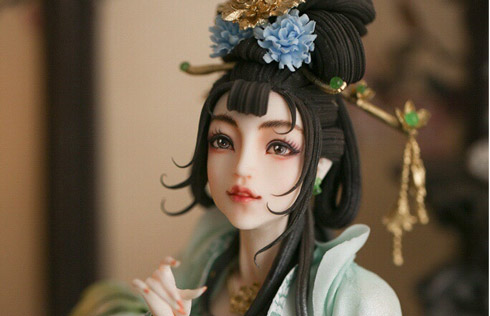Happy New Year to 'yu'

New Year's Eve is when families gather around the dinner table, and every dish on the menu represents happiness and blessings. Pauline D Loh shares the meanings behind the food
For the Chinese, a fish on the table during the Spring Festival signifies a bountiful time in the coming year. The Chinese character for fish is "yu", phonetically identical to the word representing "abundance" or "surplus".
Fish is also a popular symbol on the spring couplets that decorate doorways and lintels at this time of year. Traditional Spring Festival papercuttings also use fish as a motif, especially the carp, considered an auspicious creature in mythology. In fact, legend has it that the carp is the previous reincarnation of the mighty dragon, and it makes the magic transformation after it swims upstream and leaps over the Dragon Gate.
These myths are probably based on the carp's intense will to live. Anyone who has tried to dress a carp will have noticed how hard it is to extinguish its life. Long after it is scaled and cleaned, the carp's body will twitch, mostly due to strong muscular contractions and reflexes.
In the West, the carp is not valued for the dinner table. But the Chinese have mastered the art of cooking carp, whether it is red-cooked or braised on a bed of scallions and ginger. The only disadvantage is that the carp has plenty of slender, barbed bones.
More popular fishes during the Chinese New Year are those that are less bony, such as the pomfret or snapper. These saltwater fishes are fat and fleshy - suitable for both young and old at the reunion table.
While there are many ways to cook fish, the best way to retain their natural sweetness is to steam them. The secret is to get the cooking time just right. High heat - with water at a rolling boil - and about 15 minutes later, you have a platter of perfectly steamed fish flaking off the bone. Simple garnishes, such as finely shredded spring onions, ginger, chilies and a hot bath of sizzling aromatic oil, are the finishing touches.
While southern chefs favor delicate steaming, Sichuan and northern chefs prefer bolder flavors for their fish.
A popular way to cook fish is to add salty, tangy pickled vegetables - suan cai. These pickled mustards are finely shredded and added to the wok with sour pickled plums, a handful of dried chilies and Sichuan peppercorns. A whole fish, or a large fishhead, is added and then brought to the boil. The final dish is a large bowl of broth and meat that is powerfully aromatic and a great stimulant for both nose and palate.
Another popular dish on the table during the Spring Festival celebrations is a platter of juicy pink prawns. They are enough to make anyone smile, but especially since their name in Chinese sounds like "laughter", in some southern dialects.
In the winter months, the prawns are fat from feeding on plankton in the icy cold waters, and they are at their tastiest. They will not need much cooking, just a simple searing with a few slices of ginger and perhaps some scallions, and then a sizzle of the best quality soy sauce.
Some families prefer blanching or steaming these prawns and serving them with a soy and sesame dip, with perhaps a few slices of red chili added.
For the coming festivities this weekend, try these simple but delicious fish and prawn dishes, and may your family be blessed with much abundance and laughter in the Year of the Tiger.
CANTONESE-STYLE STEAMED FISH

Ingredients:
1 large pomfret (about 800g)
3-4 slices ginger
1 bunch spring onions
1 stalk coriander, chopped
1-2 red chilies
1 tbsp groundnut oil
1 tsp sesame oil
1 tbsp light soy sauce
1 tsp dark soy sauce
Spring onions and coriander for garnish
Method:
1. Clean the fish and rub with salt. Pat dry and set aside.
2. Place ginger slices, sliced chilies, chopped coriander and sections of spring onions on a large platter suitable for steaming.
3. Place a pair of chopsticks on top of the herbs and carefully position the fish on top. (This prevents the fish from stewing in its own juices as it cooks, giving it a cleaner finish.)
4. Steam over high heat for 15 to 20 minutes. The eyes should pop and a knife inserted into the fleshiest part of the fish should go in like butter.
5. Carefully remove the fish and place on serving platter. Garnish with freshly cut spring onions and coriander. Discard those used in steaming.
6. In a small saucepan, heat up the oil, sesame oil and soy sauces. Heat until mixture bubbles and immediately pour over the fish. The herbs will wilt and release their aroma. Serve at once.
Food notes:
This is the classic preparation for very fresh fish in the south, where fish are bought live from aquariums or tanks and slaughtered a few minutes before cooking. Chopsticks placed under the fish during steaming is a professional tip, and the raised fish cooks easier and quicker this way. The bed of herbs and ginger infuses the fish with its fresh fragrance and this is picked up again with the garnishes. The best part of this dish is the sauce, which is delicious poured over a bowl of freshly steamed white rice.
BRAISED FISH WITH TANGY PICKLES
Ingredients:

1 large snapper or any fleshy fish (about 800g), cleaned
400g pickled mustard (xian suan cai), finely sliced
4-5 pickled plums
1 red chili, finely sliced
1 tsp Sichuan peppercorns
2-3 slices ginger, finely shredded
2 large red tomatoes, quartered
Coriander, chopped
Method:
1. Heat up a little oil in a large pan or Chinese wok, and add shredded ginger and Sichuan peppercorns. Stir fry until ginger and peppercorns are aromatic.
2. Add the finely sliced pickled mustard and toss to mix. Add sour plums and enough water to cover the ingredients in the pan.
3. When the mixture boils, slide the fish gently into the pan and add the quartered tomatoes. Cover and cook about 15 minutes.
4. Adjust seasoning and add a little sugar if necessary. Place the fish onto a deep platter and ladle over the mustard, tomatoes and sour plums.
5. Garnish with chopped coriander.
Food notes:
This is a stronger-flavored dish popular in the west and the north. The pickled mustard is the perfect foil for the delicate fish, and its intense saltiness is off-set with tangy tomatoes and sour plums. Some cooks like lots of broth with this dish. If you, too, like a soupier platter, simply add more water at Step 2.
SAUTEED PRAWNS IN SAUCE AND SPRING ONIONS

Ingredients:
10-12 large prawns
1 large bunch scallions (spring onions)
2 slices ginger, finely shredded Corn starch for dusting
1 tbsp groundnut oil
1 tbsp top grade light soy sauce
1 tsp sesame oil
Method:
1. Wash prawns, and trim off feelers and feet. Cut along the back of each prawn and remove one middle section of shell. Remove the black vein.
2. Heat up oil in a large pan or Chinese wok and fry the shredded ginger until golden brown.
3. Lightly dust each prawn with a little corn starch and place in a single layer in the pan.
4. Cook over medium heat until prawns are pink on both sides and have plenty of color.
5. Turn up the heat and add spring onions. Toss to mix.
6. Add the soy sauce and toss again to coat the prawns. Keeping heat high, continue stir-frying and add the sesame oil. Turn off heat and plate the prawns.
Food notes:
In Cantonese, this dish is called "Har Har Dai Siew", or a platter of "Merry Laughter". The reunion table is when normal frugality is abandoned for a festive treat, and the largest prawns are chosen for this savory, succulent indulgence. The prawns are sauted over medium heat and then tossed with sauce and spring onions until the shells are lightly caramelized. Buy enough prawns to serve at least two or three per person at the table. They are delicious.






















